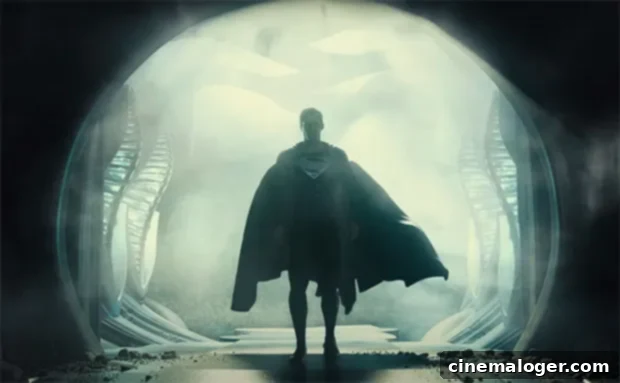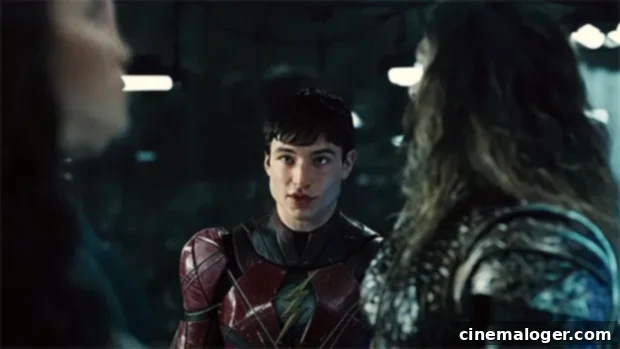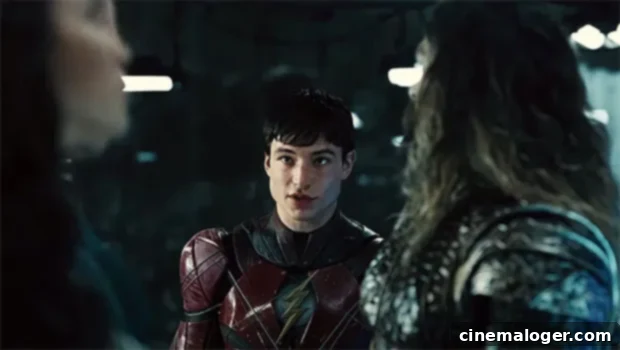Zack Snyder’s Justice League Trailer: Unveiling Darkseid, Black Suit Superman, and the Epic Road to the Snyder Cut
The moment fans have anticipated for years has finally arrived. Director Zack Snyder, at DC FanDome on August 22nd, unleashed the first full trailer for his long-awaited cut of Justice League, affectionately known as the “Snyder Cut.” This comprehensive glimpse into his original vision did not merely tease; it showcased a radically different, darker, and more complete narrative experience that promises to redefine the theatrical release from 2017. The footage immediately set the internet ablaze, revealing striking new visuals, an expanded mythology, and character arcs that were previously unseen, confirming that the Snyder Cut is not just an extended version, but an entirely new film.
The Unveiling: What the Trailer Revealed
From the first frame to the last, the trailer for Zack Snyder’s Justice League delivered on years of fan speculation and campaigning. It offered more than just new scenes; it provided a window into the director’s true narrative intent. Audiences were treated to jaw-dropping action sequences, emotionally resonant character moments, and a sense of epic scale that was largely absent from the version that hit cinemas. The trailer served as a powerful testament to Snyder’s unique directorial style, replete with his signature slow-motion, mythological undertones, and a brooding, serious tone that many felt was missing from the theatrical cut. It was a clear statement that this was the definitive version fans had fought for.
Darkseid’s Grand Entrance: A Universe-Threatening Foe
One of the most significant revelations in the Snyder Cut trailer was the undeniable presence of Darkseid. While glimpsed briefly in the theatrical cut’s history lesson, his menacing visage and active role in the trailer signified a far greater threat to Earth and the nascent Justice League. Darkseid, the tyrannical ruler of Apokolips and one of DC Comics’ most formidable villains, was clearly positioned as the overarching antagonist, a cosmic force far more terrifying than Steppenwolf, who served as the primary villain in the 2017 film. The trailer depicted Darkseid in action, showcasing his immense power and hinting at a much larger conflict that extends beyond Earth, establishing the New Gods mythology and the looming danger for the entire DC universe. His inclusion underscores Snyder’s original plan for a broader narrative arc across multiple films, setting up a truly apocalyptic confrontation.
Superman’s Iconic Black Suit: A Symbol of Resurrection and Resolve

Another striking visual that captivated audiences was the revelation of Superman in his iconic black suit. For comic book aficionados, this “Regeneration Suit” is deeply symbolic, worn by the Man of Steel after his resurrection in the “Death of Superman” storyline. Its presence in the Snyder Cut trailer strongly suggests a more nuanced and impactful return for Henry Cavill’s Kryptonian hero. While his traditional blue and red suit is undeniably his signature, the black costume conveys a sense of rebirth, raw power, and an internal struggle for the character. It’s not just a sartorial choice; it represents a darker, perhaps more pragmatic, phase for Superman as he grapples with his return and the immense threat facing Earth. This visual detail confirms Snyder’s commitment to adapting key elements from the comics that were stripped away in the theatrical release, promising a deeper exploration of Superman’s psychological journey.
The Flash and Cyborg: Expanded Backstories and Emotional Arcs

Beyond the cosmic threats and sartorial statements, the trailer also hinted at significantly expanded roles for two key Justice League members: The Flash and Cyborg. Director Zack Snyder himself emphasized that Victor Stone, also known as Cyborg, is “the heart of the movie” in his version, promising an in-depth exploration of his origin story, his struggle with his new identity, and his crucial role in holding the team together. Fans were denied much of this emotional depth in the theatrical cut, where Cyborg’s storyline felt rushed and underdeveloped. Similarly, Ezra Miller’s Barry Allen, The Flash, is set to receive a far “more emotional arc,” delving deeper into his backstory, his powers, and his connection to the Speed Force. The trailer showed glimpses of his past, highlighting the tragic elements that drive him, and hinting at more spectacular displays of his superhuman speed, transcending the mere comedic relief he was often reduced to in the 2017 film. These expanded narratives are central to Snyder’s vision of a truly character-driven ensemble piece.
The Epic Journey to the Snyder Cut
The story of the Snyder Cut is almost as epic as the film itself. Zack Snyder was the original director for Justice League, meticulously crafting a sprawling narrative meant to follow up on Man of Steel and Batman v Superman: Dawn of Justice. However, during the intense post-production phase in 2017, a personal tragedy struck: the untimely death of his daughter. Understandably, Snyder stepped down from the project to grieve and be with his family.
In his absence, Warner Bros. brought in Joss Whedon, known for his work on Marvel’s Avengers films, to complete the movie. However, Whedon’s involvement went far beyond simple post-production fixes. Extensive reshoots were conducted, dramatically altering the film’s tone, plot, and character arcs. The studio reportedly mandated a strict runtime, lighter tone, and a complete shift from Snyder’s darker, more mythological vision. The resulting theatrical cut of Justice League, released in November 2017, was widely panned by critics and disappointed many fans, who felt it was a disjointed, tonally inconsistent mess that betrayed the established style of the DCEU.
Almost immediately, a passionate movement began online, coalescing under the hashtag #ReleaseTheSnyderCut. Millions of fans worldwide demanded that Warner Bros. release Zack Snyder’s original version of the film. This unprecedented grassroots campaign gained immense traction, fueled by snippets of information from Snyder himself, storyboard leaks, and cast members expressing their support. It became a powerful demonstration of fan loyalty and collective action, sustained for over three years through social media, petitions, and even billboards in Times Square.
Against all odds, and in a move that shocked Hollywood, Warner Bros. and HBO Max announced in May 2020 that they would indeed #ReleaseTheSnyderCut. This decision, prompted by the unwavering fan demand and the strategic need for exclusive content for the nascent HBO Max streaming service, was historic. It represented a monumental victory for fans and set a new precedent for how studios might respond to persistent fan campaigns. Snyder was given the opportunity to complete his original vision, a project that reportedly required an additional investment of over $70 million to finish visual effects, editing, and potentially some minimal reshoots.
Zack Snyder’s Uncompromised Vision
Zack Snyder has always been known for his distinctive directorial style and ambitious storytelling, often drawing deeply from the source material while imbuing it with his unique cinematic language. His vision for Justice League was always intended to be an epic, character-driven saga, exploring themes of hope, loss, sacrifice, and the formation of a team of disparate heroes. The theatrical cut, at just two hours, severely compressed and altered this narrative, often sacrificing character development for brevity and levity.
Snyder has confirmed that his original version of the film was approximately four hours long. This extended runtime allowed for richer character backstories, more intricate plot developments, and a deeper exploration of the lore that underpins the DC universe. Fans can expect a more coherent narrative, where plot threads introduced in previous films are properly resolved, and new elements, like Darkseid’s full introduction, lay the groundwork for future stories. The uncompromised vision promises to be a stark contrast to the studio-mandated version, offering a true auteur’s take on the iconic superhero team.
HBO Max: A New Home for Justice
The Snyder Cut of Justice League is not merely a single, extended film; it will be presented in a unique format, specifically tailored for streaming. Zack Snyder himself confirmed that his monumental project will be released on HBO Max as four one-hour installments. This episodic approach allows the narrative to breathe, giving ample time for character development, world-building, and the unfolding of Snyder’s intricate plot without the constraints of a traditional theatrical release runtime.
This release strategy is highly significant for HBO Max, positioning it as a major player in the streaming wars. The Snyder Cut serves as a flagship exclusive, drawing subscribers to the platform and demonstrating its commitment to delivering high-quality, fan-demanded content. It also potentially opens the door for other “director’s cuts” or previously unreleased versions of films to find a home on streaming services, signaling a shift in how studios can monetize and distribute content that might not fit traditional theatrical models. The anticipation surrounding its 2021 release on HBO Max is immense, promising a truly cinematic event for home viewers.
The Stellar Cast Returns
The Snyder Cut brings back the incredible ensemble cast, allowing their performances to shine within the context of the director’s original vision. Henry Cavill returns as the iconic Superman, with his journey of resurrection and renewed purpose receiving the depth it deserves. Ben Affleck reprises his role as the hardened Batman, whose guilt and determination to unite the heroes form a critical emotional backbone of the story. Gal Gadot shines once again as Wonder Woman, bringing her strength and wisdom to the forefront. Jason Momoa’s Aquaman will have more opportunities to display his Atlantean heritage and reluctant heroism, while Ezra Miller’s The Flash and Ray Fisher’s Cyborg will finally receive the expanded backstories and emotional weight that were promised and integral to Snyder’s original narrative. The performances, now untethered from studio interference, are expected to resonate far more powerfully with audiences, allowing the actors’ initial intentions to come through.
Anticipation and Legacy
The release of Zack Snyder’s Justice League on HBO Max in 2021 is more than just a film event; it’s a cultural phenomenon. It represents a victory for passionate fandom, a testament to a director’s unwavering vision, and a bold move by a streaming service. The film is poised to have a significant impact not only on the future of the DC Extended Universe, potentially influencing future projects and character directions, but also on the film industry at large, demonstrating the power of fan engagement and the viability of director’s cuts in the streaming era.
As the countdown to its release continues, the anticipation among fans and critics alike is palpable. The Snyder Cut promises to be a transformative cinematic experience, delivering the epic scale, character depth, and thematic richness that Zack Snyder initially set out to create. It’s a film about heroes uniting against impossible odds, and in a way, its journey to the screen mirrors that very theme. Get ready for an unparalleled superhero saga, as justice finally finds its true form.
